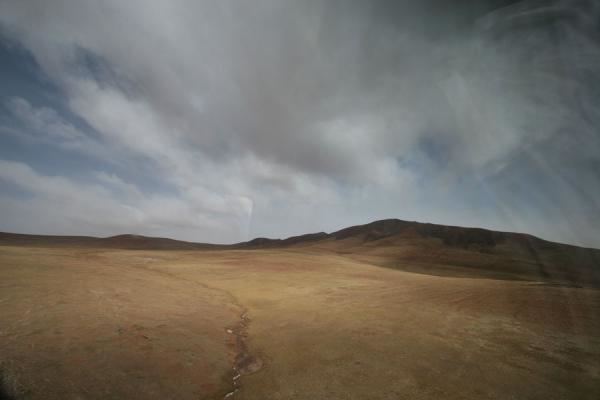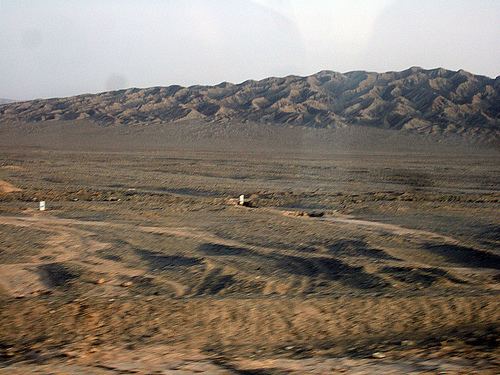Area 124,500 km2 | ||
 | ||
Map of Golmud
Golmud (Chinese: 格尔木; pinyin: Gé'ěrmù; Tibetan: ན་གོར་མོ།, Wylie: Na-gor-mo), sometimes transliterated as Ge'ermu or Geermu, is a county-level city in Qinghai Province, China, bordering Xinjiang to the northwest and the Tibet Autonomous Region to the southwest. Administrated by Haixi Mongol and Tibetan Autonomous Prefecture, it is the third largest city in Qinghai and the third largest in the Tibetan Plateau (after Xining and Lhasa). The population is now about 205,700. The name of the city derives from Mongolian, and its literal meaning in the local Western Mongolian is "Rivers".
Contents

Geography
Golmud covers a total area of 124,500 square kilometres (48,100 sq mi). This includes an urban area of 72 km2 (28 sq mi). Golmud is located in the central-south part of the Qaidam Basin with an elevation of 2,809 metres (9,216 ft). Around the city there are more than 20 salt lakes of various sizes.
A large part of the county-level city of Golmud forms an exclave, separated from the rest of the county by the western "panhandle" of the Yushu Tibetan Autonomous Prefecture. Administratively, the exclave forms the so-called Tanggula Town.
Demographics
In 1999, the population of the total area of Golmud was approximately 200,000. The town had a population of 130,000, with ethnic Han Chinese comprising 90.2%.
Economy
Due to its location, Golmud abounds with natural resources from nearby salt lakes. Thus, industries involving salt lake chemicals have sprung up. Qarham Salt Lake to the northeast of Golmud proper boasts an area of 5,856 km2 (2,261 sq mi), making it the biggest inland salt lake in the world. Qarham Salt Lake resources are estimated to be worth over 15 trillion yuan. The lake is also China's largest production base for potassium, magnesium, and salt. Golmud also possesses natural gas reserves of 1 trillion m³ (35 trillion cu. ft.) plus over 50 varieties of minerals like gold, copper, jade and precious stones, lead, and zinc. Other important industries in Golmud include petrochemicals, oil refineries, and gas fields. Statistics for 2001 show that the city's nominal GDP totalled 2.213 billion yuan, a rise of 31.9% from the previous year and the highest growth rate since 1990. The Golmud Kunlun Economic Development Zone, which consists of an area of 28 km2 (11 sq mi), was built in 1992. Golmud is planned to become "China's Salt Lake City".
Railway
Golmud lies along the Qinghai–Tibet Railway, a 1,956 km (1,215 mi) railroad that starts from Xining and ends at Lhasa in the Tibet Autonomous Region. The Golmud-Lhasa section, with a length of 1,142 km (710 mi), was the last and most challenging part of the railway to be completed. After construction of 5 years, the first train for Lhasa left Golmud on 1 July 2006.
In October 2012 construction started on the Golmud–Dunhuang Railway. It will actually branch off the Qinghai–Tibet Railway at the Yinmaxia station north of Golmud, and will cross the Qaidam Basin and the Altyn-Tagh/Qilian system on the way to Dunhuang in the neighboring Gansu province.
A planned Golmud-Korla Railway running north west from Golmud into Xinjiang province began construction in November 2014.
Highways
Airport
Climate
Golmud has a cold arid climate (Köppen BWk), with long, cold winters, and warm summers. The monthly 24-hour average temperature drops to −9.1 °C (15.6 °F) in January and rises to 17.9 °C (64 °F) in July, while the annual mean is 5.28 °C (41.5 °F). Precipitation is very low, totaling only 42 millimetres (1.65 in) per annum, falling on 28 days, most of which are during the summer. Relative humidity averages only 32%, with all months below 40%, some of the lowest levels nationally. With monthly percent possible sunshine ranging from 62% in July to 81% in November, the city receives 3,096 hours of bright sunshine annually.
